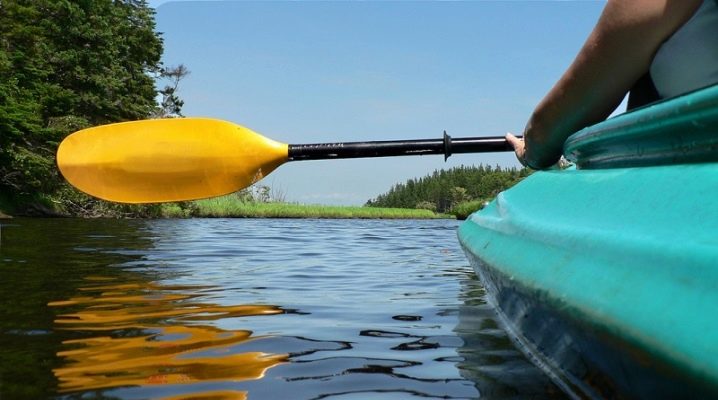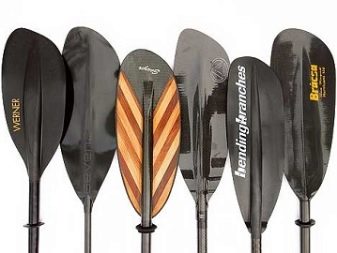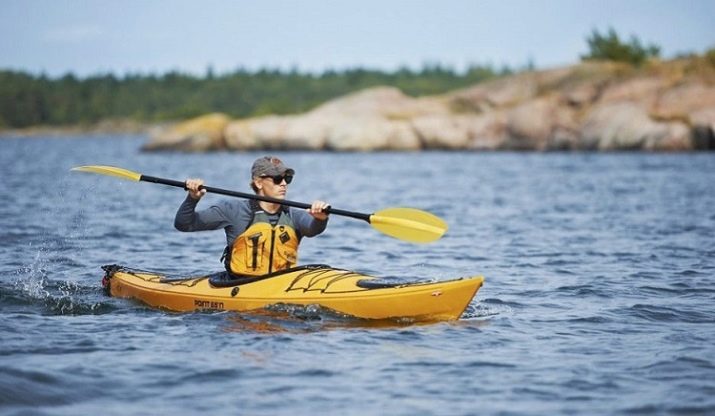Paddles for kayaks: varieties and selection rules

For kayaking or kayaking, one of the most necessary things is a paddle. Without it, being on the water is not possible. However, the choice can be a real problem, because this attribute is presented not only in several varieties, but also has a different value.
Blade shape
This indicator depends on the purpose of the oar, as well as on the physical data of the rower. Currently, all blades have an asymmetry, when the top is larger than the bottom. There are paddles for smooth water, whitewater rafting or freestyle, rowing slalom.
Rafting on a calm lake, as well as kayaking on the sea, involves smooth water. Oars for such activities are made quite narrow and long. They are helping develop speed as quickly as possible, in addition, they are suitable for sharp maneuvers.

If white water kayaking is planned, athletes choose wider and shorter oars. This is done because in this situation, not only speed is important. It is also necessary to facilitate handling and give the user the opportunity to rely on the oar. Rough water is not as dense as flat water, so using wider blades is preferable. For short oars it is better to use short blades.
Freestyle on rough water involves the performance of various elements of acrobatics. In this case, are used very short oars with very wide blades. The fact is that the emphasis on speed is practically not done, the oar serves more for support and coups. In some cases, it is allowed to use paddles for rafting, as they are very similar.

Rowing slalom is a sport where the main task of the rower is to quickly overcome a rough track with the taking of all the gates. For it are used oars with oblong blades, shaped like a spoon. This allows you to better scoop up water. Such oars allow you to quickly pick up speed, and also provide the kayak with maximum controllability, however, they are not suitable for supports.



Shaft
Shaft is duralumin tube that connects the blades. It can be either straight or curved. It should be said that the curved shaft reduces the load on the hand. With control strokes, using such an oar is much more convenient. However, users note more significant weight with less strength.

Before purchasing such an oar, you need to try it on. The fact is that the grip here will no longer be free, as in the case of a straight shaft, so you need to imagine whether it will be convenient to use it. The shaft should not slip, this can create certain difficulties when rowing. Additional measures may be required, such as wrapping the grip area with insulating tape.
Branded oars are distinguished by a drop-shaped section in this place, which allows you not to follow the angle of the oar blade turn.


Manufacturing materials
In the old days, the most commonly used material for kayak paddles was wood or aluminum alloys. It must be said that wooden oars are still found today, however, it is rather exotic, and they are not cheap. The second one has ceased to be produced at all.
Quite often, oars with an aluminum shaft and polyethylene blades are currently used. In addition, they are quite inexpensive. However, the technology itself does not allow blades of complex shape to be made. Aluminum is quite brittle, with a strong external impact, it can deform and break. A huge advantage is that due to the low cost, such products are not a pity, so they are often used by beginners, as well as people rafting on flat water.


For most oars are used composite materials. This is fiberglass, carbon, kevlar, as well as a mixture of them in different versions. I must say that in the manufacture in this case, manual labor is used, and this is reflected in the price of products.
However, there are also benefits. It must be noted that the shape of the paddle is more progressive. The light weight is an added plus. Also, composite materials are strong enough, which allows them not to break under loads.

How to choose
Before choosing a paddle, you need to decide on its purpose. This is directly related to which blade is preferable to use. Manufacturers offer paddles with blades that have the same shape, but different sizes.. This is necessary in order to choose a product in accordance with the dimensions of the rower.
Then there is the question of finance. From his decision depends on what material of manufacture the user will stop. Carbon products are more expensive, but they are more durable and will last much longer.Fiberglass has a much lower cost. You can stop at intermediate options. It must be said that different materials are used for the manufacture of oars of the same model.


The length of the paddle also varies. It should depend on the height of the person. If it does not exceed 160 centimeters, a product with a length of 190-191 cm is suitable. For people with a height of 160-180 centimeters, you should choose a paddle of 195-197 cm. And finally, for those whose height is more than 190 centimeters, an attribute of 203 cm will be required. oars also play a very important role. The fact is that the blades are placed at an angle with respect to each other. The angle can be small (10-15 degrees), as well as more serious (up to 30-45 degrees). There are no separate recommendations in this regard, it all depends on the convenience of the user.
The grip can be right and left, depending on which hand the shaft is scrolling with. To decide, you can try to do strokes right on the spot. It must be said that in most cases, athletes have a right grip.
This indicator is indicated by marking, consultants will help to understand it.

Some oars are sold disassembled and are a shaft and two blades. This allows the user to determine the optimal length and turn, and then glue the paddle as conveniently as possible for themselves. There are no particular difficulties in this matter, but accuracy must be present.
The athlete himself decides to take a product with a straight shaft or to stop at a curved one. Some stores offer thinner shafts that are designed for small women's hands.

Manufacturers offer solid and collapsible products. Parts can be from 2 to 4.Users find that solid ones are more durable, however, transportation can be difficult. For example, on an airplane, they can be recognized as oversized cargo, respectively, an additional charge will be required. Collapsible ones are most often used as spares, in case the main one breaks or gets damaged.
It must be said that The comfort and convenience of the user depends on the correct choice of paddle. It is responsible for speed, maneuvers, helps in difficult situations. A quality product can last a long time.


Case
To protect the paddle from damage, users recommend purchasing a special cover for it. His choice is not difficult. Almost all cases are equipped with shoulder straps for convenience. Worth paying attention to mesh for air circulation. It is especially relevant in cases when not yet dry oars are packed.
It should also be noted that the cases are light in weight. Therefore, users, having appreciated their advantages, often purchase this accessory along with the paddle.

How to choose a paddle for an inflatable kayak, see the following video.




























